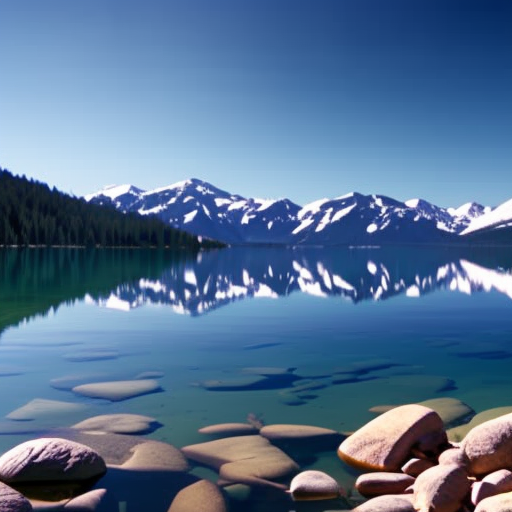Clarity, Changing Food Web Detailed in Annual Lake Tahoe Report
Clarity, Changing Food Web Detailed in Annual Lake Tahoe Report University of California, Davis


Sustainable Development Goals (SDGs) and the State of Lake Tahoe
The Tahoe Environmental Research Center (TERC) at the University of California, Davis, has released its annual Tahoe: State of the Lake Report. This report, which describes the past year as one of rapid biological change, is an important resource for restoration, management, and monitoring decisions. It provides updates on various factors affecting the health of Lake Tahoe and contributes to the achievement of the Sustainable Development Goals (SDGs).
Monitoring Lake Tahoe for Over Five Decades
UC Davis researchers have been continuously monitoring Lake Tahoe since 1968. The State of the Lake Report serves as an update for nonscientists and highlights the progress made in understanding and preserving the lake’s ecosystem. The report contributes to SDG 15 (Life on Land) by promoting the conservation and sustainable use of terrestrial ecosystems.
Rapid Changes in Lake Tahoe
The 2023 State of the Lake Report presents data collected during 2022 and highlights significant changes in the lake’s ecosystem. These changes include:
- Decline in lake clarity and its possible link to a decrease in the Mysis shrimp population
- Extensive algal blooms in the nearshore areas
- New data on microplastics
- Monitoring and modeling efforts
- Lowered nitrogen and phosphorus levels
- Research on the efficacy of no-wake zones
The report emphasizes the need for better understanding of these complex processes to effectively manage and protect Lake Tahoe. By addressing these challenges, the report contributes to SDG 14 (Life Below Water) by promoting the conservation and sustainable use of marine resources.
Nitrogen and Algae Changes
The State of the Lake Report highlights positive developments in the reduction of nutrient and fine particle loads entering Lake Tahoe. It reports a decrease in total nitrogen coming from the Upper Truckee River, the largest source of water into the lake. This reduction contributes to SDG 6 (Clean Water and Sanitation) by ensuring the availability and sustainable management of water and sanitation for all.
The report also discusses significant changes in the algal population and their rate of photosynthesis. As the water level fell in 2022 and temperatures increased, the composition of the algal community changed, with Cyanobacteria becoming the dominant phytoplankton. The report addresses SDG 13 (Climate Action) by providing insights into the impacts of climate change on Lake Tahoe’s ecosystem.
Other Highlights from the Report:
- Water levels in the lake fluctuate throughout the year based on weather conditions.
- Microplastic pollution is a concern in Lake Tahoe, with levels comparable to San Francisco Bay.
- TERC utilizes advanced technology, such as autonomous underwater vehicles, satellites, drones, and helicopters, for real-time measurements and monitoring.
- Extreme weather events, such as freezing of Emerald Bay, have an impact on the lake’s ecosystem.
- A new undergraduate student summer internship program was launched in June.
The production of the State of the Lake report was made possible through the support of various organizations, including the California Tahoe Conservancy, Mountain Workspace, Tahoe Fund, Tahoe Regional Planning Agency, Tahoe Lakefront Owners’ Association, Lahontan Regional Water Quality Control Board, The League to Save Lake Tahoe, Lake Tahoe Marina Association, Parasol Tahoe Community Foundation, Tahoe Water Suppliers Association, TruePoint Solutions, Truckee Tahoe Airport, and Incline Village Waste Not. Their contributions align with SDG 17 (Partnerships for the Goals) by fostering collaboration to achieve the SDGs.
SDGs, Targets, and Indicators
1. SDGs Addressed or Connected to the Issues Highlighted in the Article:
- SDG 14: Life Below Water
- SDG 15: Life on Land
2. Specific Targets Under Those SDGs Based on the Article’s Content:
- SDG 14.1: By 2025, prevent and significantly reduce marine pollution of all kinds, in particular from land-based activities, including marine debris and nutrient pollution.
- SDG 15.1: By 2020, ensure the conservation, restoration, and sustainable use of terrestrial and inland freshwater ecosystems and their services, in particular forests, wetlands, mountains, and drylands, in line with obligations under international agreements.
3. Indicators Mentioned or Implied in the Article:
- Indicator 14.1.1: Index of coastal eutrophication and floating plastic debris density.
- Indicator 15.1.1: Forest area as a proportion of total land area.
The article discusses the rapid biological changes in Lake Tahoe, highlighting issues such as changes in lake clarity, algal blooms, microplastics, and the decline of the Mysis shrimp population. These issues are directly connected to SDG 14 (Life Below Water) and SDG 15 (Life on Land).
Based on the content of the article, specific targets under these SDGs can be identified. For SDG 14, the target is to prevent and significantly reduce marine pollution of all kinds, including marine debris and nutrient pollution. This target is relevant to the issues of algal blooms and microplastics mentioned in the article.
For SDG 15, the target is to ensure the conservation, restoration, and sustainable use of terrestrial and inland freshwater ecosystems. This target is relevant to the issues of changes in lake clarity and the decline of the Mysis shrimp population discussed in the article.
The article mentions or implies two indicators that can be used to measure progress towards the identified targets. Indicator 14.1.1, which measures the index of coastal eutrophication and floating plastic debris density, is relevant to the issue of algal blooms and microplastics. Indicator 15.1.1, which measures forest area as a proportion of total land area, is relevant to the issue of changes in lake clarity and the decline of the Mysis shrimp population.
4. Table: SDGs, Targets, and Indicators
| SDGs | Targets | Indicators |
|---|---|---|
| SDG 14: Life Below Water | Target 14.1: By 2025, prevent and significantly reduce marine pollution of all kinds, in particular from land-based activities, including marine debris and nutrient pollution. | Indicator 14.1.1: Index of coastal eutrophication and floating plastic debris density. |
| SDG 15: Life on Land | Target 15.1: By 2020, ensure the conservation, restoration, and sustainable use of terrestrial and inland freshwater ecosystems and their services, in particular forests, wetlands, mountains, and drylands, in line with obligations under international agreements. | Indicator 15.1.1: Forest area as a proportion of total land area. |
The table above summarizes the findings from analyzing the article. It lists the relevant SDGs, their corresponding targets, and the specific indicators identified in the article. SDG 14 addresses marine pollution, including marine debris and nutrient pollution, while SDG 15 focuses on the conservation and restoration of terrestrial and inland freshwater ecosystems. The specific targets and indicators mentioned in the article align with these SDGs.
Behold! This splendid article springs forth from the wellspring of knowledge, shaped by a wondrous proprietary AI technology that delved into a vast ocean of data, illuminating the path towards the Sustainable Development Goals. Remember that all rights are reserved by SDG Investors LLC, empowering us to champion progress together.
Source: ucdavis.edu

Join us, as fellow seekers of change, on a transformative journey at https://sdgtalks.ai/welcome, where you can become a member and actively contribute to shaping a brighter future.







